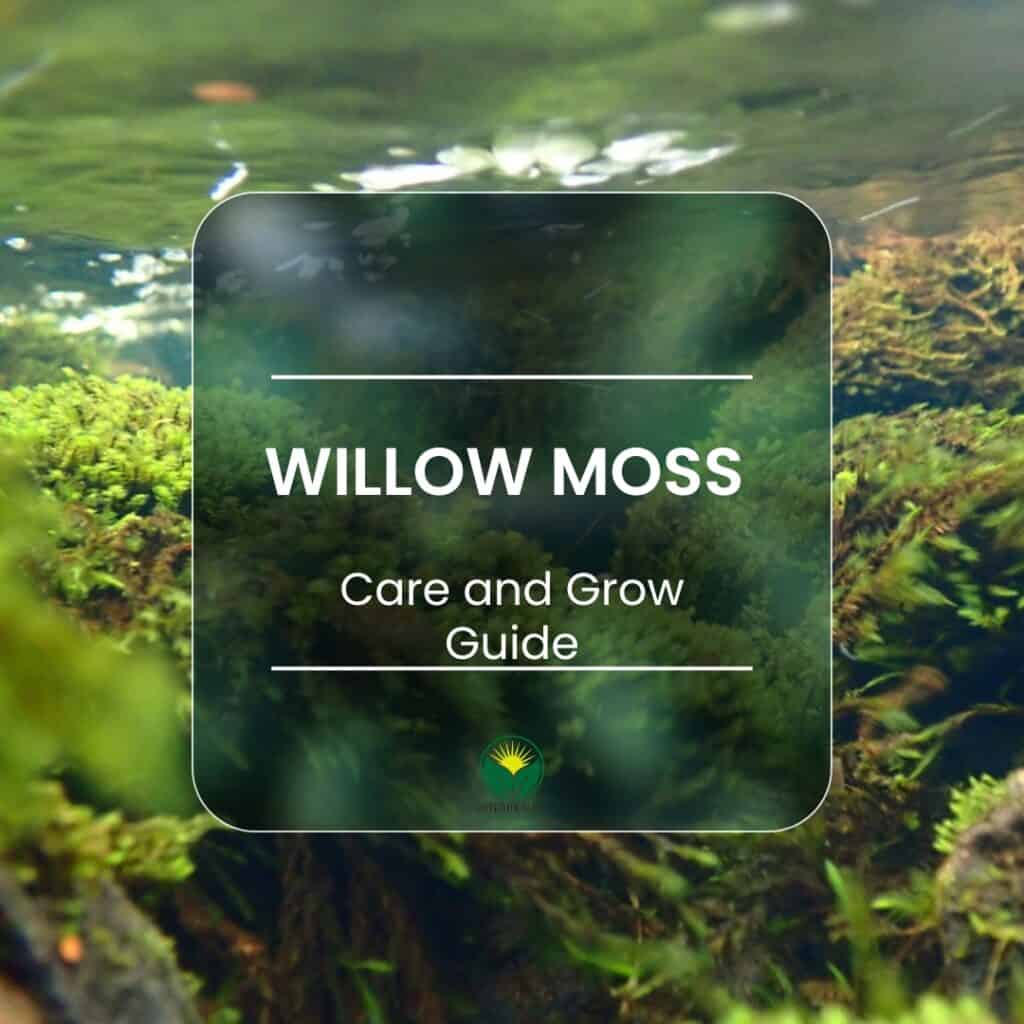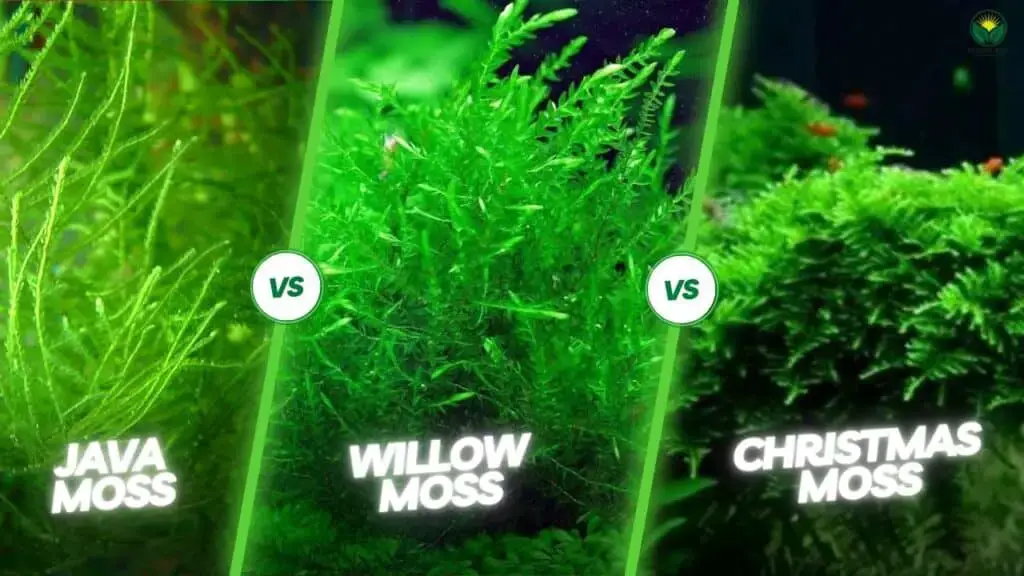
When we talk about willow moss or also called water moss (Fontinalis Antipyretica), the exciting thing is that we are talking about one of the most common aquatic mosses. Also, among the most used in aquascraping yet there is little information about it. So my task today is to give justice to an excellent moss that can be used in aquariums and in terrariums or paludariums.
Willow moss is found almost everywhere, from areas of still water to attached to rocks or logs along flowing waters.
Its stems are very reminiscent of willow tree, hence the commonly used name willow moss.
It is also commonly known as common water moss due to its high diffusion in freshwater places.
Scientific name: Fontinalis Antipyretica.
Leaf: Quite stiff, pointed leaves are 0.15 to 0.4 inches long.
Stem: The branched stem is 0.7 to 2 inches long
Flower: none; instead, it produces spores. Spores and their release are produced only on plants subjected to periods of drying out of water.
Propagation: mainly by stolons and fragments of leafy plants. Rarely from spores.
Importance of the plant: Provides habitat for aquatic insects, larvae, and other microorganisms. Small species of the fish nest there. It is a popular plant choice for cold water aquariums.
Habitat: North America, Europe, Asia, and Africa.
Aqua moss is found attached to rocks or logs in fast-flowing water or floating loose or attached to the substrate in still water. It is common in shady sites and prefers slightly acidic waters. Need water below pH 8.4.
Growth: Slow.
Water: Requires mild water temperatures not exceeding 50 to 60 Fahrenheit. Above 20°, your willow moss will turn brown quickly.
It can be confused with: Java Moss which is suitable for tropical aquariums
It comes in several varieties, and one of these, the Giant Moss Willow, boasts the record as the largest moss in the world. Think it can extend over 78 inches.
Willow moss also stands out for being able to absorb nitrates and metals, making it a test tool for some universities. This is very useful in aquariums as it will help keep the water clean and improve its quality.
How to Care for Willow Moss
Its great diffusion indicates great flexibility and adaptability to the surrounding environment. in fact, Willow moss does not require special care.
Considering that it is a water moss and therefore kept out of water for long periods, it will turn brown and start to dry. It does not require significant water changes and will help improve the quality of the water by keeping it clean by absorbing all the metals it can.
The only caution on the water, Willow moss requires cold water at most 60 degrees Fahrenheit, beyond which it will tend to die within five weeks at most.

It does not require a particular substrate and anchors well to both wood and rocks.
It does not require additions of CO2, and if, on the one hand, with the addition of CO2, you could accelerate its growth and transform it from slow to medium, on the other hand, it will tend to grow in height more than necessary.
Key elements of Willow moss care.
– Cold water. Willow moss is a cold water moss.The temperature must stay below 60 degrees Fahrenheit
– Infrequent replacements. Just change the water every two weeks
– CO2 not required. You can add it to accelerate growth, however.
– Underwater. Must stay underwater; otherwise, dry
– Lighting requirements. Indirect light is fine, avoid direct sunlight
– Water hardness. 8.5 pH
How to Grow Willow Moss
Willow moss is the perfect plant for beginners. Not only for the few cares to devote themselves to it but also for how easy it is to cultivate and propagate it. Easily attaches to any substrate from rocks to wood or plastic. You can fix it with string, glue, or even scotch tape. Usually two weeks is enough for the moss to take root on the new support, after which you can also remove any string or scotch tape.
How to grow willow moss in an aquarium or vivarium
– First, rinse the moss well and place it for 24 hours in a basin full of water; this will remove any parasites hidden in the moss.
– Take the moss and fix it to a support; you can use glue, string, or scotch tape.
– Immerse the moss with its stand in your aquarium or vivarium and wait 2 to 4 weeks.
– at this point, your willow moss will be perfectly attached to its new support.
Willow Moss Propagation
Propagation of willow moss is as simple as everything about it. In a nutshell, just cut a tuft of moss that has grown in your aquarium and place it in a basin of water by anchoring it to support, as explained before, or even leaving it free in the water; the important thing is that it does not stay out of the water.
The only attention is more aesthetic and concerns the cutting method. You can also use your hands to separate a tuft of moss from your aquarium, but this process, in addition to being inaccurate, risks causing more moss to detach than necessary. The best method is to use scissors; not only will they allow you to make a more precise cut, but they will minimize the moss residue that can float around your tank and make it dirty.
Willow Moss vs Java Moss vs Christmas moss for Aquarium

Oh, if you are designing your aquarium, paludarium, etc., this is the juiciest part of the whole article. Because choosing the correct moss to insert underwater is a challenging choice. Therefore, I want to help you choose by comparing willow moss with the other two most used aquatic mosses, java moss and Christmas moss.
Willow moss, Java moss, and Christmas moss are both popular aquatic plants that are often used in aquariums and terrariums. However, there are some key differences between the two. Here is a summary of the main differences between willow moss, Java moss, and Christmas moss:
Appearance:
Willow moss is a kind of aquatic moss with delicate leaves similar to a willow tree. It is generally a dark bright green color and has a pointed appearance.
Java moss is a species of water moss with small, delicate leaves that grow in a dense tufted carpet. It is typically bright green in color and has a softer, more delicate appearance than willow moss.
Christmas moss is a kind of water moss with small, delicate leaves that grow in a thick carpet-like mat. It is typically bright green in color and has a delicate, frond-like appearance.
Growth rate:
In terms of growth speed, Java moss grows faster than the other two, while in terms of size, no one beats the giant Willow moss.
Willow moss is a kind of aquatic moss with delicate leaves similar to a willow tree. It is generally a dark bright green color and has a pointed appearance.
Java moss is a species of water moss with small, delicate leaves that grow in a dense tufted carpet. It is typically bright green in color and has a softer, more delicate appearance than willow moss.
Christmas moss is a kind of water moss with small, delicate leaves that grow in a thick carpet-like mat. It is typically bright green in color and has a delicate, frond-like appearance.
Care requirements:
All three mosses only require a little attention, change the water every two weeks and respect the common precautions for any aquarium.
Willow moss is generally considered a low-maintenance and easy-to-care-for plant. It can tolerate a wide range of lighting, temperature, and pH conditions and is tolerant of both hard and soft water. Is best moss for beginner
Java moss is also low maintenance and easy to care for plants. It can tolerate a wide range of lighting, temperature, and pH conditions and is tolerant of both hard and soft water.
Christmas moss is a low-maintenance plant that is easy to care for. It can tolerate a wide range of lighting, temperature, and pH conditions and is tolerant of both hard and soft water.
Uses:
As far as use is concerned, Christmas moss is preferred when you want to create a horizontal pattern. For tropical aquariums, java moss is perfect for all generic aquariums. In contrast, willow moss, as it loves colder waters, is suitable for aquariums with temperatures below 60 degrees Fahrenheit.
Willow moss, Java moss, and Christmas moss are all commonly used aquatic moss species in aquascaping and aquariums. Here is a comparison of the main differences between these three species:
Overall, all three moss species are attractive, low-maintenance plants that are well-suited to a range of aquatic environments. The specific species you choose will depend on your personal preferences, the appearance and growth rate you are looking for, and how willingly you can find them.
Where to Buy Willow Moss
If you live in Europe or the USA and are fond of mountain walking, you could easily find it in small streams.
If, on the other hand, you prefer to buy it, you should know that it is more challenging to find online than its substitutes, Java Moss or Christmas Moss. I always look on Etsy and Amazon, but various smaller alternatives have quality moss. If you are interested, you can write to me, and I will be happy to send you more specific information.